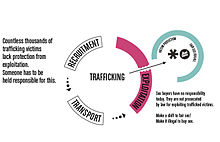
Back الاتجار بالجنس Arabic যৌন উদ্দেশ্যে মানব পাচার Bengali/Bangla Sex trafficking German Sex trafficking English Tráfico sexual Spanish قاچاق جنسی Persian סחר בבני אדם למטרות מין HE Սեռական թրաֆիքինգ Armenian Perdagangan seks ID Ajhuwâlân jima' MAD

Le trafic sexuel est le trafic d'êtres humains à des fins d'exploitation sexuelle, y compris l'esclavage sexuel, qui est considéré comme un esclavage contemporain[1]. Par divers stratagèmes, une victime de trafic sexuel tombe contre son gré dans une situation de dépendance vis-à-vis du trafiquant avant d'être obligée de fournir des prestations sexuelles à des clients[2]. La criminalité du trafic sexuel recouvre l'acquisition, le transport et l'exploitation de personnes[1], y compris le tourisme sexuel impliquant des enfants, les actes sexuels avec un mineur contre rémunération et d'autres variantes d'exploitation sexuelle commerciale des enfants, ainsi que leur prostitution[2].
En 2012, l'Organisation internationale du travail (OIT) annonce que 20,9 millions de personnes sont victimes de travail forcé, dont 24 % (4,5 millions) dans l'exploitation sexuelle contrainte[3]. En 2016, l'OIT rapporte que sur 25 millions de personnes forcées de travailler, 5 millions sont victimes d'exploitation sexuelle[4],[5]. Toutefois, comme le trafic sexuel est une activité clandestine, les chercheurs rencontrent des difficultés pour proposer des statistiques précises et fiables[6]. Le trafic sexuel peut être aussi présent dans le milieu de la pornographie, comme dans l'exemple du scandale GirlsDoPorn en 2020.
En 2005, une estimation des profits générés mondialement par le trafic sexuel avance le chiffre de 9 milliards de dollars[7],[8]. D'après l'OIT en 2017, l'exploitation sexuelle à des fins commerciales rapporte 99 milliards de dollars aux trafiquants à l'échelle mondiale[9].
- (en) Siddharth Kara, Sex Trafficking: Inside the Business of Modern Slavery, Columbia University Press, (ISBN 9780231139618, lire en ligne)
- (en) Gretchen Hammond et Mandy McGlone, « Entry, Progression, Exit, and Service Provision for Survivors of Sex Trafficking: Implications for Effective Interventions », Global Social Welfare, vol. 1, no 4, , p. 157-168 (DOI 10.1007/s40609-014-0010-0
 ), citing (en) Maria Beatriz Alvarez, Edward J. Alessi, « Human trafficking is more than sex trafficking and prostitution: implications for social work », Affilia, vol. 27, no 2, , p. 142-152 (DOI 10.1177/0886109912443763, S2CID 59404870)
), citing (en) Maria Beatriz Alvarez, Edward J. Alessi, « Human trafficking is more than sex trafficking and prostitution: implications for social work », Affilia, vol. 27, no 2, , p. 142-152 (DOI 10.1177/0886109912443763, S2CID 59404870)
- (en) « ILO 2012 Global estimate of forced labour - Executive summary », International Labour Organization (consulté le ).
- Odhiambo, Agnes & Barr, Heather. (2 Aug 2019). "Opinion:Trafficking survivors are being failed the world over." Al Jazeera website Retrieved 4 August 2019.
- International Labour Organization. (19 septembre 2017). Press Release:40 million in modern slavery and 152 million in child labour around the world. International Labour Organization website Retrieved 4 August 2019.
- (en) Susan Tiefenbrun, « The Saga of Susannah A U.S. Remedy for Sex Trafficking in Women: The Victims of Trafficking and Violence Protection Act of 2000 », Utah Law Review, vol. 107,
- Daffron, Joshua W. (Dec 2011). "Combating Human Trafficking: Evolution of State Legislation and the Policies of the United Kingdom and France." Thesis, M.A. Monterey, Calif.:Department of National Security Affairs. Naval Postgraduate School. Defense Technical Information Center website Retrieved 2 December 2018.
- Tiziana Luise. (2005). “Are human rights becoming burdensome for our economies? The role of slavery-like practices in the development of world economics and in the context of modern society,” Rivista Internazionale Di Scienze Sociali, 113(3): 473.
- "Human Trafficking by the Numbers". (January 7, 2017). Human Rights First website Retrieved 2 December 2018.